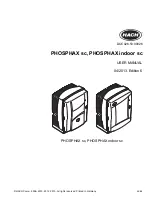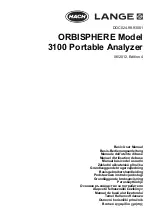
56 • Calibration Mode
GX-2012 Operator’s Manual
Calibration Mode
Calibration Mode allows you to calibrate the GX-2012’s sensor response and to bump test
the GX-2012.
The unit should be calibrated periodically. The optimum frequency of calibration depends
heavily on how the GX-2012 is used. For example, instruments used daily may need to be
calibrated weekly or monthly, while instruments that are used only a few times a year may
need to be calibrated before each use. Typical calibration frequencies range from monthly
to quarterly.
You can program the GX-2012 to notify you when it is due for calibration. See “Updating
the Calibration Reminder Setting” on page 119.
Calibration/Bump Test Supplies and Equipment
To calibrate or bump test the GX-2012, you will need:
•
Known calibrating samples of the gases being detected. The combustible and toxic gas
samples should have concentrations in approximately the middle of the range of
detection. An oxygen-free source, such as 100% nitrogen is recommended for setting
the oxygen zero when using single calibration.
•
A demand-flow regulator to provide adequate sample gas flow
•
Non-absorbent tubing
CAUTION:
If you are using a calibration kit that includes a gas bag and a fixed flow
regulator or dispensing valve, do not apply gas directly to the GX-2012
with the regulator or valve or damage to the pump will result. See
“Appendix A: Calibrating and Bump Testing with a Sample Bag” on
page 148 for instructions to properly use a gas bag kit.
To calibrate or bump test the %LEL, Oxygen, CO, and H
2
S sensors at the same time,
automatically, with no need for a zero-oxygen source, you can use the auto calibration
feature with a 4-gas cylinder. If the H
2
S channel is not active, then a 3-gas cylinder may be
used for auto-calibration. This section includes instructions for auto calibration and bump
testing with a demand-flow regulator, a 4-gas cylinder, and a %volume methane cylinder.
This section also includes instructions for calibrating one channel at a time using single
calibration.
NOTE:
If the combustible gas channel(s) are calibrated to a gas other than
methane, use an appropriate multigas cylinder or use single calibration
to calibrate the combustible channel(s).
Preparing for Calibration or Bump Testing
Whether you will calibrate the GX-2012 using auto calibration, single calibration, or
perform a bump test, you will need to set the fresh air readings first.
1. Find a fresh-air environment. This is an environment free of toxic or combustible
gases and of normal oxygen content (20.9%).
2. Turn on the unit as described in “Turning On the GX-2012, Normal Mode Only” on
page 23 or in “Turning On the GX-2012 in Normal Mode With All Modes Active” on
page 28. Use the sample hose and probe.
www.calcert.com
1.800.544.2843
0
5
10
15
20
25
30
















































